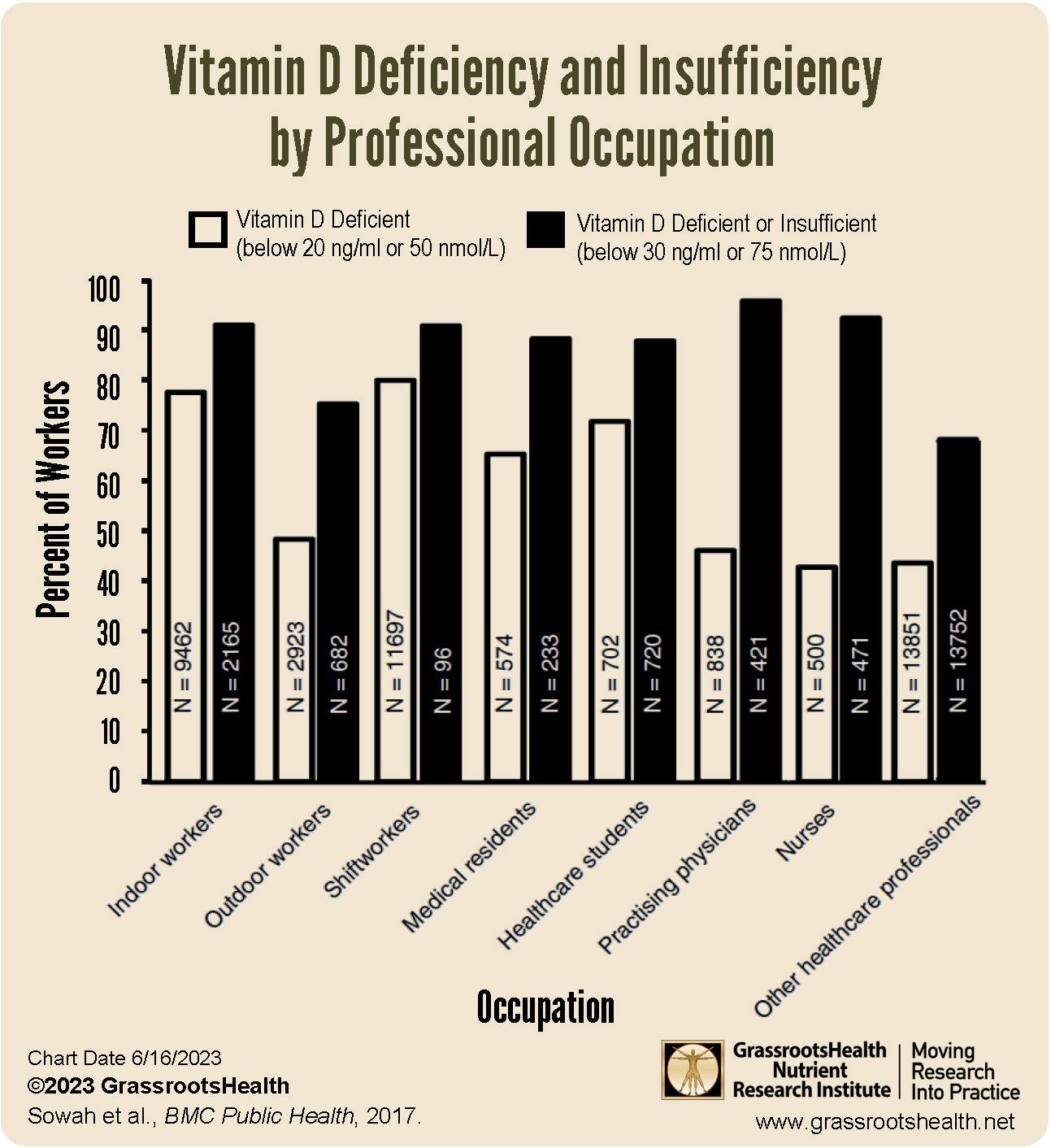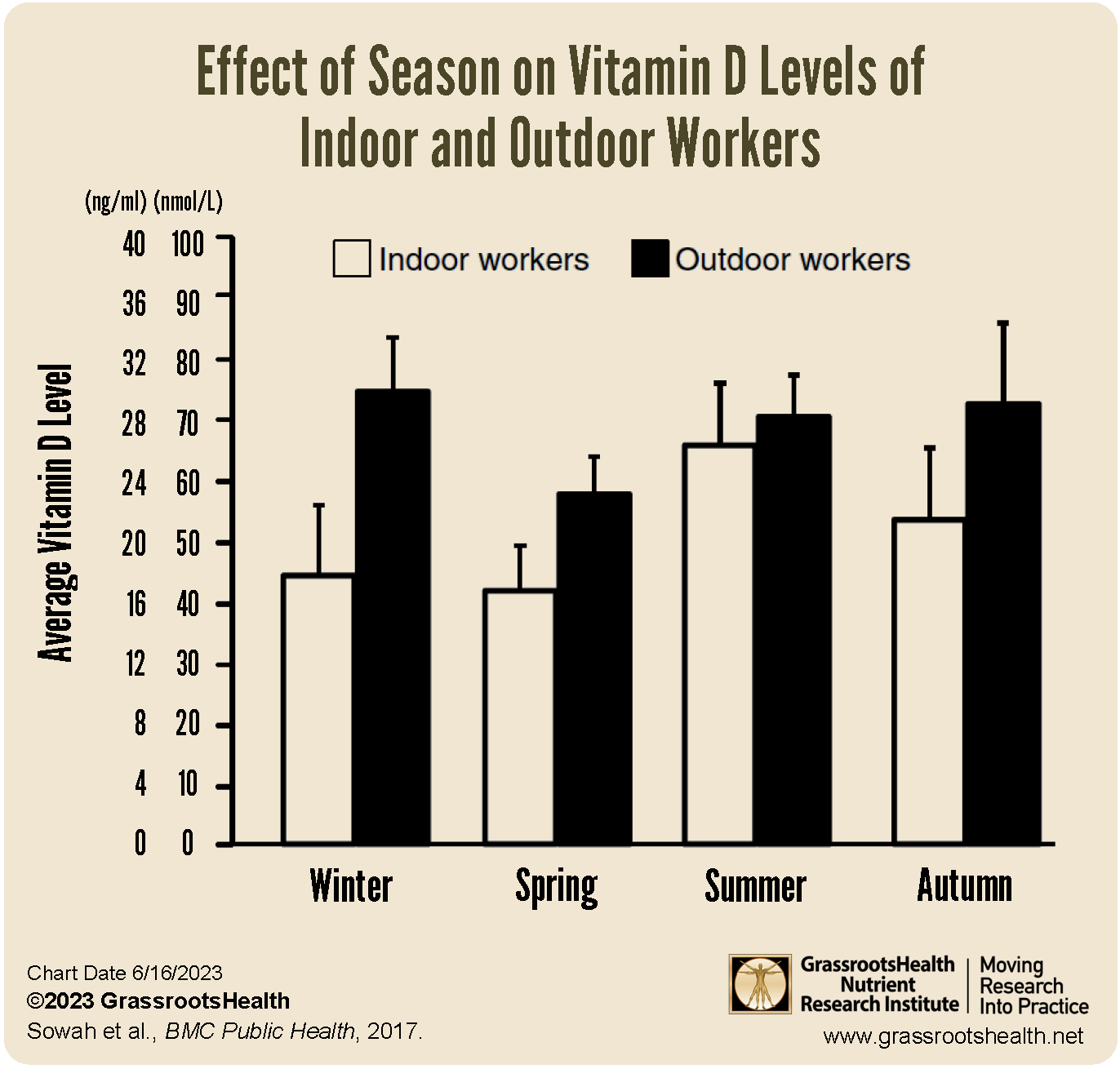Published on June 19, 2023
Does your job affect your vitamin D status? Should certain occupations have specific guidelines and actions to take for vitamin D?
Key Points
- A study examining vitamin D levels among individuals working in different occupations found that, while rates of vitamin D deficiency and insufficiency were high among all occupations examined, deficiency was highest among shift workers and lowest among lead/smelter workers
- An average vitamin D level of 25 ng/ml (62 nmol/L) was found among all healthcare professionals included in the study, with rates of vitamin D deficiency at 72% among healthcare students, 65% among medical residents, 46% among practicing physicians, 44% among other healthcare employees, and 43% among nurses
- Regardless of season, outdoor workers maintained a higher vitamin D level compared to indoor workers. Among outdoor workers, vitamin D levels were lowest during the spring compared to any other season, and levels during the winter were comparable to summer and autumn levels for outdoor workers; for indoor workers, the highest vitamin D levels were found during the summer, and the lowest levels were in spring and winter.
 A review by Sowah et al. looked at data from 71 peer-reviewed studies to determine how vitamin D levels differed among individuals working in different occupations. The review included indoor and outdoor workers, shift workers, lead/smelter workers, coalminers, and healthcare professionals. The authors also evaluated the effect of season on vitamin D levels between the different groups.
A review by Sowah et al. looked at data from 71 peer-reviewed studies to determine how vitamin D levels differed among individuals working in different occupations. The review included indoor and outdoor workers, shift workers, lead/smelter workers, coalminers, and healthcare professionals. The authors also evaluated the effect of season on vitamin D levels between the different groups.
For the purpose of this study, vitamin D deficiency was defined as a 25(OH)D level below 20 ng/ml (50 mol/L), and insufficiency was defined as a level between 20-30 ng/ml (50-75 nmol/L).
Who was Most Deficient in Vitamin D?
The rates of vitamin D deficiency were
- 80% among shift workers (91% were insufficient or deficient)
- 78% among indoor workers (91% were insufficient or deficient)
- 48% among outdoor workers (75% were insufficient or deficient)
This study found that the rates of vitamin D deficiency and insufficiency were not dependent on study location or latitude when looking at both vitamin D levels of indoor and outdoor workers. Shift workers had the lowest vitamin D levels of all others, with the highest risk of vitamin D deficiency.
The occupation with the highest vitamin D levels were lead/smelter workers; this was the only group whose vitamin D level, on average, was above 30 ng/ml (75 nmol/L).
A Closer Look at Healthcare Workers
When evaluating data from 19,083 healthcare workers, an average vitamin D level of 25 ng/ml (62 nmol/L) was found. The study took a closer look at healthcare professionals to find that the rates of vitamin D deficiency among different healthcare professionals was
- 72% among healthcare students
- 65% among medical residents
- 46% among practicing physicians
- 44% among other healthcare employees
- 43% among nurses
The chart below illustrates the rates of vitamin D deficiency (white bars; below 20 ng/ml) and vitamin D deficiency or insufficiency (black bars; below 30 ng/ml) among each of the healthcare professions examined.
Did Season Affect Vitamin D Levels?
Data was analyzed to determine the effect of season on vitamin D levels for indoor workers compared to outdoor workers. This analysis found that, regardless of season, outdoor workers maintained a higher vitamin D level compared to indoor workers. Among outdoor workers, vitamin D levels were lowest during the spring compared to any other season; an interesting finding showed vitamin D levels during the winter were comparable to summer and autumn levels for outdoor workers.
For those working indoors, the highest vitamin D levels were found during the summer, and the lowest levels were in spring and winter.
Are You and Your Loved Ones Getting Enough Vitamin D and Other Important Nutrients?
The only way to know is to test your levels! Testing versus blind supplementation is essential to know for sure if what you are taking is the right amount for you. Once you test your vitamin D (and other levels) to know where you are NOW, you can account for any upcoming changes in lifestyle over the coming months and adjust your intake to reach (or maintain) your targets.
- Vitamin D
- Magnesium PLUS Elements
- Omega-3 Fatty Acids
- hsCRP
- HbA1c
- TSH
- Type 1 Diabetes Autoantibodies
Did you know that each of the above can be measured at home using a simple blood spot test? As part of our ongoing research project, you can order your home blood spot test kit to get your levels, followed by education and steps to take to help you reach your optimal target levels. Start by enrolling and ordering your kit to measure each of the above important markers, and make sure you are getting enough of each to support better mood and wellbeing!
Create your custom home test kit today. Take steps to improve the status of each of these measurements to benefit your overall health. With measurement you can then determine how much is needed and steps to achieve your goals. You can also track your own intakes, symptoms and results to see what works best for YOU.
Enroll in D*action and Test Your Levels Today!








